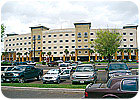
Before UVC, the four 465-ton chillers serving the Rio Grande Regional Hospital were running at 99% capacity. Eighteen months later, the hospital had been able to shut two of the chillers down, and the other two were running at 62% capacity.
The rising cost of A/C energy is a problem for hospitals everywhere, and McAllen, TX is no exception. In a town where 90°F-plus days are common and the mercury can top 100o even in winter, the seasons might be described as “hot and hotter.”
But at McAllen’s Rio Grande Regional Hospital, an HCA-affiliated 320-bed hospital, administrators are staying cool with the knowledge that - even in the face of a 33% utility rate hike - their electric bill has declined over the past two years. “We attribute this to the incorporation of UVC lights from Steril-Aire, Inc. into the air-handling systems,” said Oscar Molano, director of plant operations for the hospital.
LETTING THE LIGHT SHINE IN
“We were looking for a way to save on A/C energy costs without compromising air quality or patient comfort,” Molano explained. Working with Rio Filter Supply Company, he learned that Steril-Aire’s high-output UVC devices offer multiple performance benefits. Installed in air handlers, the germicidal UVC energy emitted by the devices penetrates the tiniest microbes to destroy their DNA and RNA, killing or deactivating them. UVC degrades mold and other organisms that grow deep inside HVAC systems as well as airborne microbes that circulate to the occupied space.Decades-old studies have shown that even a microscopic layer of organic buildup on A/C coil fins can create a noticeable drop in system efficiency. By eliminating buildup, UVC devices keep coils continuously clean - lowering HVAC energy costs by improving heat transfer and increasing net cooling capacity.
At Rio Grande Regional, 17 AHUs were nine years old and ranged from 20 to 80 tons. Nine AHUs were four years old and 70 to 80 tons. After re-viewing the benefits, Molano received approval to retrofit all 26 AHUs (manufactured by Carrier and Temtrol) with UVC.
“We started early in 2005 and converted one or two AHUs every month thereafter,” said Molano. The devices used are Steril-Aire DE Series UVC Emitters™, which are designed for installation in large commercial HVAC systems. “As our UVC retrofit program has progressed, we have seen continuing and dramatic improvement in energy performance,” said Molano.
REDUCED CAPACITY = DECREASED ELECTRICAL USAGE
Before UVC, the four 465-ton chillers serving the hospital were running at 99% capacity. Chilled water “in” measured at 43o, chilled water “out” at 64o.Eighteen months later, after most of the AHUs had been equipped with UVC, the same chillers were running at only 62% capacity. Chilled water “in” remained at 43o, but chilled water “out” temperature had decreased to 53o, an 11o drop.
During that period, electrical usage (in kWh hours) declined 20.64%. This cancelled out a utility rate increase from $.06 per kWh to $.08 per kWh. Thus, with the addition of UVC in 2005 and 2006, electrical energy costs from 2005 to 2006 remained at a constant average of $166,900 per month.
By fall of 2006, as Rio Grande was wrapping up the conversion to UVC, they determined that the hospital was now too cold, even with the chillers running at reduced capacity. In late October, they shut down two chillers completely, along with the accompanying chilled water pumps, condenser water pumps, and cooling towers.
The two operating chillers are now running at 80% capacity, with chilled water “in” at 43o and chilled water “out” temperature at 60o. Kilowatt hours continued to decline. From January through May 2007, energy expense was down $240,885 compared to the same time period in 2006 - a 29.5% savings. Based on this trend, annual energy savings in the $500,000-plus range can be projected.
“The recent cutback to two chillers will bring even more reductions in our energy cost,” said Molano. “UVC technology has made a remarkable difference. We used to need four chillers even when the temperature outside was 70o, and now two chillers do the job at 90°.”
All 26 AHUs are now running in “as new” condition. Every drain pan is pristine with no need for further cleaning. Though the hospital still does occasional pressure-washing of A/C coils with water, they have eliminated the use of acid for cleaning. Rio Filter Supply performs all services on UVC Emitters including periodic checks and measurements of performance. “Our nursing staff, patients and others seem very happy with the air quality in the facility,” Molano said.
